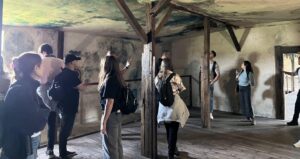Although Messianic Jewish believers are in the minority among the total Jewish population, today a remnant of tens of thousands worship Jesus as Messiah all over the world. In Israel alone, there are some 30,000 Jewish believers. Has that always been the case? Let’s look at the remnant throughout history, from the time of Jesus till today.
When the Holy Spirit came at Pentecost over 3000 Jews believed the the message that first disciples eagerly proclaimed in the temple courts. Later we read that the number of followers had reached 5000 (Acts 4:4) including priests and Pharisees (6:7 and 15:5). Acts 21:20 records:
“They said to Paul: “You see, brother, how many thousands [Greek: muriades – myriads] of Jews have believed, and all of them are zealous for the law!””
But then what?
How many Jewish people have really believed in Jesus throughout the rest of history?
There were between 60,000-80,000 Jewish people resident in Jerusalem in the first century, and approximately 6 million globally[1], so even though many thousands believed, the number was still only a small remnant among world Jewry at the time.
However, the number was significant enough to be noted in Jewish history. Josephus tells us that the unfair trial and execution of Yakov, brother of Yeshua, who was martyred for his faith in Yeshua in 62 CE, was an unpopular decision among the people (Ant 20:9).
Most people know of the famous Yeshiva star called Saul (Paul) who left the feet of Gamaliel to dedicate his life to teaching others about the coming of the Messiah, but did you know that the famous Rabbi Hillel II also came to faith in Yeshua towards the end of his life?
Hillel II’s deathbed confession of Yeshua as Messiah was witnessed by one of his rabbinical students called Joseph of Tiberius, who became a believer through his teacher’s testimony.[2]
There were Jewish believers leading the church – for example, in the time of Claudius Caesar, a Jewish man called Euodius was appointed as bishop of Antioch by Apostle Peter (another Jewish disciple) until his martyrdom in 68 CE. Evaristus was another Jewish martyr and bishop of Rome circa 100 CE (Liber Pontificalis).
Hegesippus was a Jewish Nazarene believer in the second century, and an early church historian. Although other early church leaders like Ignatius wrote against maintaining Jewish practice, Ignatius’ letters to the Philadelphian and Magnesian congregations shows that there were many Jewish people among them, some of whom had abandoned Jewish practices and others who had not.
Similarly, John Chrysostom’s anti-semitic writings indicate that there were Jewish believers in Yeshua still maintaining Jewish identity and the traditions of their ancestors well into the fourth century CE, much to his frustration. Epiphanius (303-403 CE), was the bishop of Constantia in Cyprus in his time, and though he was Jewish, he trained in monastic circles. By this time, the pressure on Jewish people who believed in Yeshua to identify only as “Christians” and to renounce their Jewish identity was extreme.
Saint Patrick (late 300s to 461 CE) is thought to have been a Messianic Jew, from a family who kept Jewish customs and lifestyle, like ritual purity traditions, celebrating Passover instead of Easter, and observing Shabbat. Attempts to edit his Jewish heritage out of the picture during a time of deep antisemitism in the church didn’t manage to cover the tracks completely.
The scant evidence of Jewish believers after the fourth century is due to the fact that the Jewish Messianic believers hid their Jewish identity, rather than ceased to exist. However, from the Middle Ages onwards, we see more and more evidence of Jewish people following Yeshua as their Messiah, especially in the last three centuries.
It would be impossible to catalogue them all here, but here are some of the most noteworthy Jewish believers from the eleventh century until today:
Moses Sephardi / Petrus Alfonsi (1062-1110) was a famous Jewish physician, writer, astronomer, and polemicist from Spain, who publicly declared his faith in Yeshua on St Peter’s day, 29th June 1103. He was later sent to England to serve as court physician of Henry I.
Gregory Abu’l Faraj (1226-1286), born in Melitena, was the son of the Aaron the Jewish physician. Master of Greek, Syriac and Arabic, student of philosophy, theology and medicine, he became an ordained Bishop of Gubos at 20, then again Maphrian of the Eastern Church at 40. At his death, none were found in the Jacobite church to equal his spiritual stature. He was appropriately named Abu’l Faraj, meaning “father of comfort.”
Rabbi Solomon Halevi (1351-1445) was a respected physician. He examined the Messianic prophecies he was baptized at the age of 31, taking the name Pablo de santa Maria. After studying theology, he later became Archbishop of Burgos. Sadly, Halevi had become complicit in harsh treatment of his own people and was influenced by the anti-semitism in the church at the time. Other Jewish believers accused of anti-Judaism were Nicholas Donin in France, Pablo Christiani, and Hieronymus de Sancta Fide (Joshua Lorki) in Spain, and Petrus Nigri (Schwartz) in Germany, but misrepresentation of the entire context of Judeo-Christian polemics in the 14th century has contributed to the inaccurate stigmatization of all Messianic Jews as apostates.
Alfonso de Zamora was a Spanish rabbi who chose to follow Yeshua in 1506. Working with Paul Nunez Coronel and Alfonso d’Alcala, two other Jewish believers, he became the key Hebraist among the polyglot translators of the Bible during the Renaissance. Johann Harzuge was the first to print a New Testament in the Hebrew language in Cracow, Poland, in 1540. In the next several years Paul Halicz, Paul Emulio, and Michael Adam also produce Hebrew and Yiddish translations of the New Testament.
Johannes & Stephan Isaac, a father and son from Germany, decide to follow Yeshua in 1546. Johannes became a professor of Hebrew at the University of Cologne and Stephan a priest.
Rodrigo Lopez was a refugee from the Inquisition in Portugal to England in 1559, but became a believer and rose to become physician to Queen Elizabeth in 1586.
Judah Jonah of Safed, later known as Giovanni Battista Jona (1588-1678) became assistant rabbi in Hamburg, but was later baptized in Poland in 1625. He went to Italy where he became professor of the University of Pisa, and later one of the Vatican Librarians.
Malachi ben Samuel, a Polish rabbi, comes to faith in Messiah around 1621, several years after being impressed by a Yiddish translation of the New Testament.
Theodore John of Prague was a student and then teacher of Talmud and Rabbinic writings in Treves, Germany, but in 1692 declared his faith in Yeshua as Messiah, declaring “I found the said Christian faith to be in all its articles firmly grounded upon the Word of God, and agreeing with the faith of the former true Israel, in the time of the Patriarchs, as well as that of Moses and all the Prophets; which I praise God for, and heartily rejoice in.”
Rabbi Judah Monis was the first Jewish person to receive a college degree in America (M.A., Harvard, 1720). He publicly embraced faith in Yeshua in 1722 and joined the faculty at Harvard as a Hebrew teacher. His gravestone reads, “A native branch of Jacob see. Which once from off its olive brook, Regrafted, from the living tree”.[3]
Michael Solomon Alexander (1799-1845) Having grown up in Prussia in a strictly Orthodox Jewish home, he quickly became a teacher of Talmud. Aged 21 he traveled to England as a rabbi, but was given a New Testament. After studying it in secret, he eventually came to believe in Yeshua, and was dismissed from his rabbinic duties. He was the first Anglican bishop in the Middle East.
Benjamin Disraeli, Prime Minister of England (1804-1881) was a Jewish man who was convinced that, “Jesus came to complete the ‘law and the prophets.’” Throughout his career in Parliament he very publicly attacks those with anti-Semitic views, often with biting wit, and shows himself to be a proud Zionist. In a statement to Queen Victoria, he said: “Your Majesty, I am the blank page between the Old Testament and the New”.
Isaac Lichtenstein (1824-1908) was the Chief Rabbi of Hungary who was surprised by what he found in the New Testament when he read it, and came to faith in Jesus. In a letter to his son, he wrote, “From every line in the New Testament, from every word, the Jewish spirit streamed forth light, life, power, endurance, faith, hope, love, charity, limitless and indestructible faith in God.”
Joseph Rabinowitz (1837-1899) This Talmudic scholar and Lawyer came to faith in Yeshua in 1885, and, through writings and lectures, begins influencing Russian Jews to become “Sons of the New Covenant”. He formed one of the early Messianic Congregations.
Hans Herzl, son of Theodore Herzl. After growing up at an Orthodox Jewish boarding school, he came to believe in Yeshua in 1924. The Baltimore Jewish Times reported that, “he believed that if the idea of Jewish nationalism is thought to its final conclusion one can be a Christian Jew”, but that due to his beliefs he was written out of Jewry.
Haham Ephraim ben Joseph Eliakim was a Rabbi in Tiberias who came to believe that Yeshua was the Messiah after studying the biblical prophecies. He was buried in Jerusalem in 1930 alongside a Christian Arab, with one reporter noting that, “Jew and Arab were laid one beside the other, and Jews and Arabs were standing with bowed heads by the two open graves, touched and softened the one toward the others.”
Mortimer Adler (1902-2001) was a Professor of Philosophy at the University of Chicago. Author of numerous books on philosophical topics, Adler becomes a Jewish believer at age 84. “We have a logical, consistent faith,” he says. “In fact, I believe [faith in Messiah] is the only logical, consistent faith in the world.”
Hugh Montefiore (1920-2005) The great-great nephew of Moses Montefiore, Hugh was raised in a traditional Jewish home, but came to believe in Yeshua as a teenager. He then served in World War II as a captain in the Royal Artillery, and later graduated from Oxford University. He went on to became Dean and lecturer at Cambridge University, then served as a vicar and later bishop in the Church of England.
Richard Wurmbrand (1909-2001) was born into a Jewish home, and though he started life as an atheist and intellectual, he later became convinced of the truth of the New Testament. He became a pastor of Jewish believers in Romania, many of whom perished in the Holocaust. He was imprisoned and tortured for his faith under the Communists for 15 years before his eventual release. He was voted one of the five greatest Romanians of all time[4].
Bob Dylan was born in 1941, originally named Robert Allen Zimmerman (Hebrew name Shabtai Zisl ben Avraham), and came to believe in Jesus in the 1970s. In 2011 he played in Tel Aviv and opened his set with the song, “Gonna Change My Way of Thinking” from his first openly Messianic album, with the lyrics, “Jesus is coming. He’s coming on back to gather his jewels”.
Joseph Baruch Shulam (1946-) is from a Bulgarian Jewish family who settled in Jerusalem in 1948, but 14 years later, he came to faith in Yeshua the Messiah. He studied Bible, Archeology and Jewish Thought at Hebrew University, and then Rabbinics and Jewish Thought at the Diaspora Yeshiva. He established Netivyah, an Israeli-government recognized organization, providing a bridge between Jews and Christians and Judaism and Christianity, and nurturing the Messianic Jewish community in Israel.
Today there are over 350 000 Jewish people who love and follow Yeshua, both in Israel and abroad.
To read more examples, see:
http://www.messianicassociation.org/profiles.htm
http://www.israelinprophecy.org/ENGLISH/live_site/brief_list-most_famous_messianic_jews.html
[1] Levine Lee I (2002) Jerusalem: Portrait of the City in the Second Temple Period 538 B.C.E. – 70 C.E., Jewish Publication Society, pp.156, 213, 313
[2] Epiphanius, Panarion, Part 30, 4:1-5:4
[3] Jewish Virtual Library
[4] Mari Români poll, 2006
















